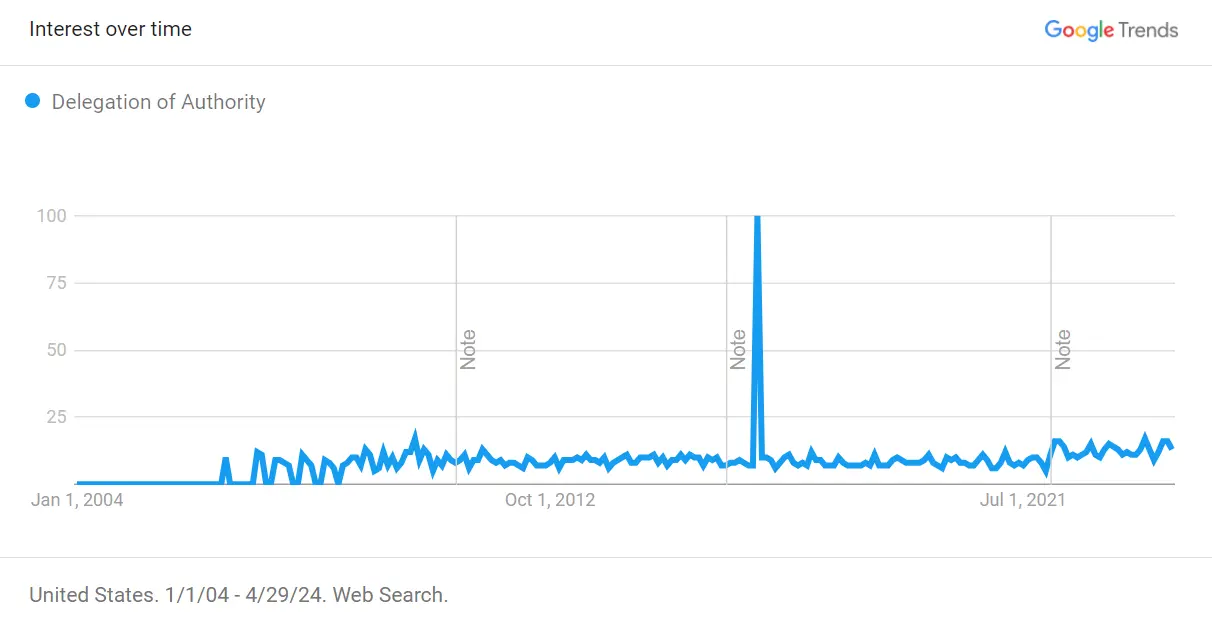A well-implemented DOA plays a vital role in compliance management. In today’s regulatory environment, businesses must adhere to various laws and standards.
A DOA ensures that all actions are in compliance with these regulations by providing a structured framework for decision-making. This not only mitigates legal risks but also enhances the organization’s reputation as a responsible corporate citizen.
Here’s what you need to know about DOA in business.
What is a DOA?

A Delegation of Authority (DOA) is a document that outlines the levels of authority within an organization. It delineates who has the power to make decisions, approve actions, and authorize expenditures.
Find Out More: What is a Chief Business Officer? Role and Skills Needed
Importance of DOA in Business
DOA is vital for maintaining order and efficiency within a company. It establishes clear guidelines for decision-making, ensuring that tasks are carried out swiftly and with accountability.
- Clarity in Decision Making: A DOA provides clarity on who has the authority to make decisions, ensuring that actions are taken promptly and with accountability.
- Compliance with Regulations: By defining authority levels, a DOA helps ensure that all actions taken within the organization comply with relevant regulations such as the Sarbanes-Oxley Act (SOX) or the Health Insurance Portability and Accountability Act (HIPAA).
- Risk Management: Having a DOA in place helps manage risks by clearly outlining approval processes and ensuring that decisions are made by individuals with the appropriate expertise.
- Efficient Resource Allocation: With a DOA, resources can be allocated more efficiently as decisions are made by individuals who understand the needs of the organization.
- Legal Protection: A well-defined DOA can provide legal protection to the organization by demonstrating that decisions were made in accordance with established procedures, reducing the risk of legal challenges.
- Conflict Resolution: By clearly defining authority levels, a DOA helps prevent conflicts over decision-making, fostering a harmonious work environment.
- Enhanced Communication: With a DOA in place, communication flows more smoothly as employees know who to approach for approvals and clarifications.
Understanding DOA
A DOA is a formal document that defines the authority levels within an organization. It specifies the scope of decision-making for each position or department.
Components of a DOA
A Delegation of Authority (DOA) comprises several key components that define the framework for decision-making within an organization.
Authority Levels
- Authority levels outline the extent of decision-making power held by individuals or positions within the organization.
- This component delineates who has the authority to approve various actions, from routine tasks to significant expenditures.
Approval Hierarchy
- The approval hierarchy establishes the chain of command for seeking approvals.
- It outlines the order in which approvals should be obtained, ensuring that decisions are made by individuals with the appropriate level of authority.
Document Types Covered
- This component specifies the types of documents or actions covered by the DOA.
- It defines the scope of the DOA, including which decisions require approval and which can be made autonomously by employees.
Decision Criteria
- Decision criteria provide guidelines for evaluating proposals or requests for approval.
- These criteria ensure that decisions are made based on relevant factors such as financial implications, strategic alignment, and risk assessment.
Exceptions and Escalations
- Exceptions and escalation procedures define how to handle situations that fall outside the standard approval process.
- They outline the circumstances under which exceptions may be granted and the process for escalating decisions to higher levels of authority.
Revocation and Amendments
- This component specifies how the DOA can be amended or revoked.
- It outlines the procedures for updating the DOA to reflect changes in the organization’s structure, operations, or regulatory requirements.
Documentation and Communication
- Documentation and communication requirements ensure that the DOA is well-documented and accessible to all relevant stakeholders.
- This component includes provisions for maintaining records of approvals and communicating changes to employees.
Training and Awareness
- Training and awareness programs ensure that employees understand the DOA and how to adhere to it.
- This component includes training sessions, informational materials, and ongoing communication to promote awareness of the DOA throughout the organization.
Compliance Monitoring
- Compliance monitoring mechanisms ensure that the DOA is being followed and that decisions are made in accordance with established procedures.
- Regular monitoring and audits help identify any deviations from the DOA and address them promptly.
Integration with Other Policies and Procedures
- The DOA should be integrated with other organizational policies and procedures, such as risk management frameworks and compliance programs.
- This integration ensures consistency and alignment across various aspects of organizational governance.
Benefits of Implementing a DOA
Implementing a DOA brings several benefits to a business:
- Helps everyone know who makes decisions.
- Makes things run smoother.
- Keeps everything legal and up to standard.
- Avoids problems and mistakes.
- Makes sure resources are used in the best way.
- Protects the company from legal troubles.
- Stops arguments about who should decide what.
- Works well as the company grows.
- Shows clearly who is responsible for what.
- Makes it easier to talk about decisions.
- Can be changed to fit new situations.
- Gives workers the power to make decisions.
- Saves money by avoiding mistakes and delays.
- Gets things done quicker.
- Keeps decisions fair and the same for everyone.
How to Develop a DOA
Developing a DOA involves several key steps:
Step 1: Assess Organizational Needs
- Identify the specific needs and structure of the organization.
- Understand the existing decision-making processes and areas where improvements are needed.
Step 2: Define Objectives
- Clearly define the objectives of the DOA.
- Determine the desired outcomes, such as improved efficiency, compliance with regulations, or better risk management.
Step 3: Identify Key Stakeholders
- Identify the key stakeholders who will be involved in the development and implementation of the DOA.
- This may include senior management, department heads, legal advisors, and compliance officers.
Step 4: Establish Authority Levels
- Define the levels of authority within the organization.
- Determine who has the authority to make decisions at various levels, from routine tasks to major strategic decisions.
Step 5: Develop Approval Processes
- Establish clear approval processes for different types of decisions.
- Define the steps involved in seeking approvals, including the documentation required and the individuals or committees responsible for granting approvals.
Step 6: Document the DOA
- Document the DOA in a clear and concise manner.
- Include all relevant information, such as authority levels, approval processes, decision criteria, and escalation procedures.
Step 7: Communicate the DOA
- Communicate the DOA to all relevant stakeholders.
- Ensure that employees understand their roles and responsibilities under the DOA through training sessions, informational materials, and ongoing communication.
Step 8: Implement the DOA
- Implement the DOA across the organization.
- Ensure that all employees are aware of the DOA and adhere to its guidelines in their day-to-day activities.
Step 9: Monitor and Evaluate
- Regularly monitor the implementation of the DOA.
- Evaluate its effectiveness in achieving the desired objectives and make adjustments as necessary.
Implementing a DOA
Implementing a DOA effectively requires:
- Clear communication to ensure all employees understand the DOA.
- Training programs to educate employees on the DOA.
- Making the DOA easily accessible to all staff.
- Regularly monitoring adherence to the DOA.
- Establishing channels for employees to give feedback on the DOA.
- Gaining support from management for DOA implementation.
- Keeping the DOA up-to-date with any changes in the organization.
- Being open to adjustments based on feedback and changing needs.
- Enforcing consequences for violations of the DOA.
- Integrating the DOA into the company culture.
- Recognizing and rewarding compliance with the DOA.
- Being transparent about the reasons behind the DOA and its importance.
- Establishing a feedback loop for continuous improvement.
- Providing ongoing training to ensure understanding.
- Leading by example in following the DOA.
FAQs
- What is the difference between a DOA and an SOP?
A DOA defines authority levels, while an SOP (Standard Operating Procedure) outlines specific steps for performing tasks.
- How often should a DOA be updated?
A DOA should be updated whenever there are changes in the organization’s structure or processes.
- Is a DOA necessary for small businesses?
Yes, a DOA is beneficial for businesses of all sizes to ensure clarity and accountability.
- What happens if someone violates the DOA?
Violating the DOA can lead to disciplinary action, depending on the severity of the violation.
- Can a DOA be too restrictive?
Yes, a DOA should strike a balance between providing guidance and allowing flexibility. Overly restrictive DOAs can stifle innovation and agility.




